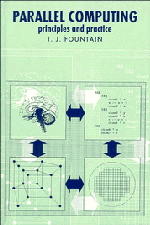4 - Connectivity
Published online by Cambridge University Press: 29 September 2009
Summary
Whilst the two issues of control (what are all these parallel processors going to do?) and programming (how is the user to tell them all what to do?) are perhaps the most difficult conceptual aspects of parallel computing, the question of the connections between all the many system components is probably the hardest technical problem. There are two main levels at which the problem must be considered. At the first level, the connections between major system components, such as CPU, controller, data input and output devices, must be given careful consideration to avoid introducing bottlenecks which might destroy hoped-for performance. At the second level, connections within these major components, particularly between processing units and their associated memories, will be the major controlling factor of overall system performance. Within this area, an important conceptual difference exists between two alternative approaches to inter-processor communication. Individual pairs of elements may be either externally synchronised, in which case a controller ensures that if data is input at one end of a line it is simultaneously accepted at the other, or unsynchronised. In this latter case, the donating element signals that data is available, but the data is not transferred until the receiving element is ready to accept it.
In addition to this, technical problems are present. The first is the position and purpose of memory in the general structure.
- Type
- Chapter
- Information
- Parallel ComputingPrinciples and Practice, pp. 123 - 165Publisher: Cambridge University PressPrint publication year: 1994



